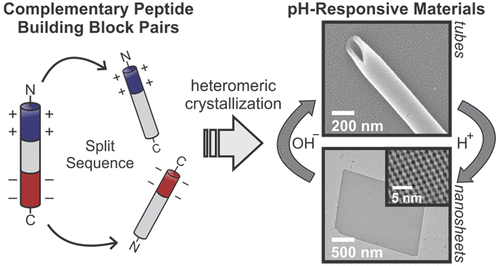当前位置:
X-MOL 学术
›
J. Am. Chem. Soc.
›
论文详情
Our official English website, www.x-mol.net, welcomes your
feedback! (Note: you will need to create a separate account there.)
Shape-Shifting Peptide Nanomaterials: Surface Asymmetry Enables pH-Dependent Formation and Interconversion of Collagen Tubes and Sheets
Journal of the American Chemical Society ( IF 14.4 ) Pub Date : 2020-11-10 , DOI: 10.1021/jacs.0c08174 Andrea D. Merg 1 , Gavin Touponse 1 , Eric van Genderen 2 , Thorsten B. Blum 2 , Xiaobing Zuo 3 , Alisina Bazrafshan 1 , Hew Ming Helen Siaw 1 , Arthur McCanna 4 , R. Brian Dyer 1 , Khalid Salaita 1 , Jan Pieter Abrahams 2, 5 , Vincent P. Conticello 1
Journal of the American Chemical Society ( IF 14.4 ) Pub Date : 2020-11-10 , DOI: 10.1021/jacs.0c08174 Andrea D. Merg 1 , Gavin Touponse 1 , Eric van Genderen 2 , Thorsten B. Blum 2 , Xiaobing Zuo 3 , Alisina Bazrafshan 1 , Hew Ming Helen Siaw 1 , Arthur McCanna 4 , R. Brian Dyer 1 , Khalid Salaita 1 , Jan Pieter Abrahams 2, 5 , Vincent P. Conticello 1
Affiliation

|
The fabrication of dynamic, transformable biomaterials that respond to environmental cues represents a significant step forward in the development of synthetic materials that rival their highly functional, natural counterparts. Here, we describe the design and synthesis of crystalline supramolecular architectures from charge-complementary heteromeric pairs of collagen-mimetic peptides (CMPs). Under appropriate conditions, CMP pairs spontaneously assemble into either 1D ultraporous (pore diameter >100 nm) tubes or 2D bilayer nanosheets due to the structural asymmetry that arises from heteromeric self-association. Crystalline collagen tubes represent a heretofore unobserved morphology of this common biomaterial. In-depth structural characterization from a suite of biophysical methods, including TEM, AFM, high-resolution cryo-EM, and SAXS/WAXS measurements, reveals that the sheet and tube assemblies possess a similar underlying lattice structure. The experimental evidence suggests that the tubular structures are a consequence of the self-scrolling of incipient 2D layers of collagen triple helices and that the scrolling direction determines the formation of two distinct structural isoforms. Furthermore, we show that nanosheets and tubes can spontaneously interconvert through manipulation of the assembly pH and systematic adjustment of the CMP sequence. Altogether, we establish initial guidelines for the construction of dynamically responsive 1D and 2D assemblies that undergo a structurally programmed morphological transition.
中文翻译:

变形肽纳米材料:表面不对称性使胶原管和片材的 pH 依赖性形成和相互转化成为可能
响应环境线索的动态、可转化生物材料的制造代表了合成材料发展的重要一步,可与它们的高功能天然材料相媲美。在这里,我们描述了从电荷互补异聚体对的胶原蛋白模拟肽 (CMP) 中设计和合成晶体超分子结构。在适当的条件下,由于异聚体自缔合引起的结构不对称,CMP 对会自发地组装成一维超多孔(孔径 >100 nm)管或二维双层纳米片。结晶胶原管代表了这种常见生物材料迄今为止未观察到的形态。一系列生物物理方法的深入结构表征,包括 TEM、AFM、高分辨率冷冻电镜、和 SAXS/WAXS 测量表明,板和管组件具有相似的底层晶格结构。实验证据表明,管状结构是胶原三螺旋初始二维层自滚动的结果,滚动方向决定了两种不同结构异构体的形成。此外,我们表明纳米片和管可以通过操纵组装 pH 值和 CMP 序列的系统调整自发地相互转换。总而言之,我们为构建动态响应的 1D 和 2D 组件建立了初始指南,这些组件经历了结构编程的形态转换。实验证据表明,管状结构是胶原三螺旋初始二维层自滚动的结果,滚动方向决定了两种不同结构异构体的形成。此外,我们表明纳米片和管可以通过操纵组装 pH 值和 CMP 序列的系统调整自发地相互转换。总而言之,我们为构建动态响应的 1D 和 2D 组件建立了初始指南,这些组件经历了结构编程的形态转换。实验证据表明,管状结构是胶原三螺旋初始二维层自滚动的结果,滚动方向决定了两种不同结构异构体的形成。此外,我们表明纳米片和管可以通过操纵组装 pH 值和 CMP 序列的系统调整自发地相互转换。总而言之,我们为构建动态响应的 1D 和 2D 组件建立了初始指南,这些组件经历了结构编程的形态转换。我们表明,纳米片和管可以通过操纵组装 pH 值和系统地调整 CMP 序列而自发地相互转换。总而言之,我们为构建动态响应的 1D 和 2D 组件建立了初始指南,这些组件经历了结构编程的形态转换。我们表明,纳米片和管可以通过操纵组装 pH 值和系统地调整 CMP 序列而自发地相互转换。总而言之,我们为构建动态响应的 1D 和 2D 组件建立了初始指南,这些组件经历了结构编程的形态转换。
更新日期:2020-11-10
中文翻译:

变形肽纳米材料:表面不对称性使胶原管和片材的 pH 依赖性形成和相互转化成为可能
响应环境线索的动态、可转化生物材料的制造代表了合成材料发展的重要一步,可与它们的高功能天然材料相媲美。在这里,我们描述了从电荷互补异聚体对的胶原蛋白模拟肽 (CMP) 中设计和合成晶体超分子结构。在适当的条件下,由于异聚体自缔合引起的结构不对称,CMP 对会自发地组装成一维超多孔(孔径 >100 nm)管或二维双层纳米片。结晶胶原管代表了这种常见生物材料迄今为止未观察到的形态。一系列生物物理方法的深入结构表征,包括 TEM、AFM、高分辨率冷冻电镜、和 SAXS/WAXS 测量表明,板和管组件具有相似的底层晶格结构。实验证据表明,管状结构是胶原三螺旋初始二维层自滚动的结果,滚动方向决定了两种不同结构异构体的形成。此外,我们表明纳米片和管可以通过操纵组装 pH 值和 CMP 序列的系统调整自发地相互转换。总而言之,我们为构建动态响应的 1D 和 2D 组件建立了初始指南,这些组件经历了结构编程的形态转换。实验证据表明,管状结构是胶原三螺旋初始二维层自滚动的结果,滚动方向决定了两种不同结构异构体的形成。此外,我们表明纳米片和管可以通过操纵组装 pH 值和 CMP 序列的系统调整自发地相互转换。总而言之,我们为构建动态响应的 1D 和 2D 组件建立了初始指南,这些组件经历了结构编程的形态转换。实验证据表明,管状结构是胶原三螺旋初始二维层自滚动的结果,滚动方向决定了两种不同结构异构体的形成。此外,我们表明纳米片和管可以通过操纵组装 pH 值和 CMP 序列的系统调整自发地相互转换。总而言之,我们为构建动态响应的 1D 和 2D 组件建立了初始指南,这些组件经历了结构编程的形态转换。我们表明,纳米片和管可以通过操纵组装 pH 值和系统地调整 CMP 序列而自发地相互转换。总而言之,我们为构建动态响应的 1D 和 2D 组件建立了初始指南,这些组件经历了结构编程的形态转换。我们表明,纳米片和管可以通过操纵组装 pH 值和系统地调整 CMP 序列而自发地相互转换。总而言之,我们为构建动态响应的 1D 和 2D 组件建立了初始指南,这些组件经历了结构编程的形态转换。











































 京公网安备 11010802027423号
京公网安备 11010802027423号